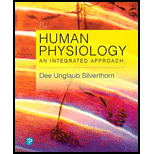
Human Physiology: An Integrated Approach (8th Edition)
8th Edition
ISBN: 9780134605197
Author: Dee Unglaub Silverthorn
Publisher: PEARSON
expand_more
expand_more
format_list_bulleted
Question
Chapter 9, Problem 19RQ
Summary Introduction
To determine: The two centers of the cortex that are involved in integrating spoken language.
Introduction: Learning is the idea of deriving knowledge through experience and practice. The learning process is very well developed in humans and some other primates. The cerebrum is the center for the learning process and also aids in retaining the memory.
Expert Solution & Answer
Want to see the full answer?
Check out a sample textbook solution
Students have asked these similar questions
Describe the hormones produced in the glands listed below:
Pituitary gland
Hypothalamus
Thyroid
Parathyroid
Adrenal
Pineal
Pancreas(islets of langerhans)
Gonads (testes and ovaries)
Placenta
Please help me calculate drug dosage from the following information:
Patient weight: 35 pounds, so 15.9 kilograms (got this by dividing 35 pounds by 2.2 kilograms)
Drug dose: 0.05mg/kg
Drug concentration: 2mg/mL
A 25-year-old woman presents to the emergency department with a 2-day history of fever, chills, severe headache, and confusion. She recently returned from a trip to sub-Saharan Africa, where she did not take malaria prophylaxis. On examination, she is febrile (39.8°C/103.6°F) and hypotensive. Laboratory studies reveal hemoglobin of 8.0 g/dL, platelet count of 50,000/μL, and evidence of hemoglobinuria. A peripheral blood smear shows ring forms and banana-shaped gametocytes. Which of the following Plasmodium species is most likely responsible for her severe symptoms?
A.
Plasmodium vivax
B.
Plasmodium ovale
C.
Plasmodium malariae
D.
Plasmodium falciparum
Chapter 9 Solutions
Human Physiology: An Integrated Approach (8th Edition)
Ch. 9.2 - Prob. 1CCCh. 9.3 - Name the four kinds of glial cells found in the...Ch. 9.3 - Prob. 3CCCh. 9.3 - Prob. 4CCCh. 9.3 - Prob. 5CCCh. 9.3 - Prob. 6CCCh. 9.3 - Prob. 7CCCh. 9.3 - Prob. 8CCCh. 9.3 - Prob. 9CCCh. 9.3 - In the late 1800s, the scientist Paul Ehrlich...
Ch. 9.3 - Prob. 11CCCh. 9.4 - Prob. 12CCCh. 9.4 - Prob. 13CCCh. 9.5 - Are the following white matter or gray matter? (a)...Ch. 9.5 - Using the information from Table 9.1, describe the...Ch. 9.5 - In anatomical directional terminology, the...Ch. 9.5 - Prob. 17CCCh. 9.5 - Prob. 18CCCh. 9.5 - Prob. 19CCCh. 9.5 - Prob. 20CCCh. 9.6 - Prob. 21CCCh. 9 - Prob. 1RQCh. 9 - Prob. 2RQCh. 9 - Prob. 3RQCh. 9 - In vertebrates, the central nervous system is...Ch. 9 - Prob. 5RQCh. 9 - Prob. 6RQCh. 9 - Prob. 7RQCh. 9 - Prob. 8RQCh. 9 - Prob. 9RQCh. 9 - Prob. 10RQCh. 9 - Prob. 11RQCh. 9 - What does cerebral lateralization refer to? What...Ch. 9 - Match each of the following areas with its...Ch. 9 - Name the 12 cranial nerves in numerical order and...Ch. 9 - Name and define the two major phases of sleep. How...Ch. 9 - List several homeostatic reflexes and behaviors...Ch. 9 - Prob. 17RQCh. 9 - What are the broad categories of learning? Define...Ch. 9 - Prob. 19RQCh. 9 - Prob. 20RQCh. 9 - Prob. 21RQCh. 9 - What are the three brain systems that regulate...Ch. 9 - Explain the role of Wernickes and Brocas areas in...Ch. 9 - Compare and contrast the following concepts: a....Ch. 9 - What properties do motivational states have in...Ch. 9 - Prob. 26RQCh. 9 - Prob. 27RQCh. 9 - Prob. 28RQCh. 9 - Mr. Andersen, a stroke patient, experiences...Ch. 9 - Prob. 30RQCh. 9 - Prob. 31RQCh. 9 - Prob. 32RQCh. 9 - Prob. 33RQ
Knowledge Booster
Learn more about
Need a deep-dive on the concept behind this application? Look no further. Learn more about this topic, biology and related others by exploring similar questions and additional content below.Similar questions
- please fill in missing parts , thank youarrow_forwardplease draw in the answers, thank youarrow_forwarda. On this first grid, assume that the DNA and RNA templates are read left to right. DNA DNA mRNA codon tRNA anticodon polypeptide _strand strand C с A T G A U G C A TRP b. Now do this AGAIN assuming that the DNA and RNA templates are read right to left. DNA DNA strand strand C mRNA codon tRNA anticodon polypeptide 0 A T G A U G с A TRParrow_forward
- Please identify the curve shown below. What does this curve represent? Please identify A, B, C, D, and E (the orange oval). What is occurring in these regions?arrow_forwardPlease identify the test shown here. 1) What is the test? 2) What does the test indicate? How is it performed? What is CX? 3) Why might the test be performed in a clinical setting? GEN CZ CX CPZ PTZ CACarrow_forwardDetermine how much ATP would a cell produce when using fermentation of a 50 mM glucose solution?arrow_forward
arrow_back_ios
SEE MORE QUESTIONS
arrow_forward_ios
Recommended textbooks for you
 Human Biology (MindTap Course List)BiologyISBN:9781305112100Author:Cecie Starr, Beverly McMillanPublisher:Cengage Learning
Human Biology (MindTap Course List)BiologyISBN:9781305112100Author:Cecie Starr, Beverly McMillanPublisher:Cengage Learning Human Physiology: From Cells to Systems (MindTap ...BiologyISBN:9781285866932Author:Lauralee SherwoodPublisher:Cengage Learning
Human Physiology: From Cells to Systems (MindTap ...BiologyISBN:9781285866932Author:Lauralee SherwoodPublisher:Cengage Learning




Human Biology (MindTap Course List)
Biology
ISBN:9781305112100
Author:Cecie Starr, Beverly McMillan
Publisher:Cengage Learning

Human Physiology: From Cells to Systems (MindTap ...
Biology
ISBN:9781285866932
Author:Lauralee Sherwood
Publisher:Cengage Learning

Animal Communication | Ecology & Environment | Biology | FuseSchool; Author: FuseSchool - Global Education;https://www.youtube.com/watch?v=LsMbn3b1Bis;License: Standard Youtube License